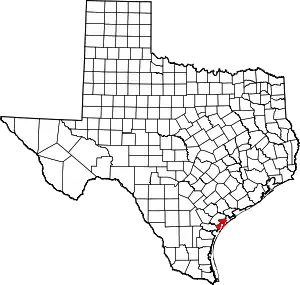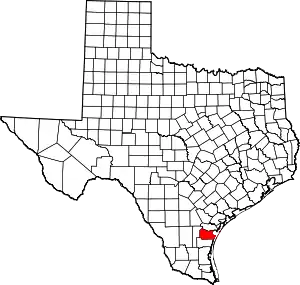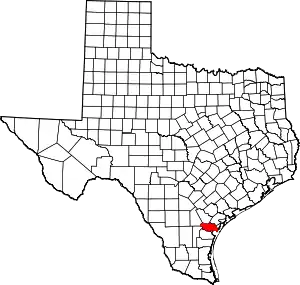Corpus Christi, Texas
Corpus Christi (/ˌkɔːrpəs ˈkrɪsti/; Ecclesiastical Latin: "Body of Christ") is a coastal city in the South Texas region of the U.S. state of Texas and the county seat and largest city of Nueces County.[5] Portions of the city also extend into Aransas, Kleberg, and San Patricio counties. It is 130 miles (210 km) southeast of San Antonio and 208 miles (335 km) southwest of Houston. Its political boundaries encompass Nueces Bay and Corpus Christi Bay. Its zoned boundaries include small land parcels or water inlets of three neighboring counties.
Corpus Christi | |
|---|---|
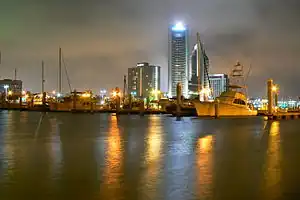 Downtown bayfront | |
 Flag 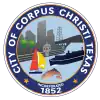 Seal | |
| Nickname: Sparkling City by the Sea | |
 Location within Nueces County | |
 Corpus Christi Location within Texas  Corpus Christi Location within United States | |
| Coordinates: 27°44′34″N 97°24′7″W | |
| Country | United States |
| State | Texas |
| Counties | Nueces, Kleberg, San Patricio, Aransas[1] |
| Named for | Body of Christ |
| Government | |
| • Type | Council–manager government |
| • City council | Mayor Paulette Guajardo (D) Michael Hunter John Martinez Mike Pusley Billy A. Lerma Ben Molina Roland Barrera Greg Smith Gil Hernandez |
| • City manager | Peter Zanoni |
| Area | |
| • City | 488.73 sq mi (1,265.80 km2) |
| • Land | 160.63 sq mi (416.03 km2) |
| • Water | 328.10 sq mi (849.77 km2) |
| Elevation | 7 ft (2 m) |
| Population (2020) | |
| • City | 317,863 |
| • Estimate (2021) | 317,773 |
| • Rank | US: 59th |
| • Density | 2,033.17/sq mi (785.01/km2) |
| • Urban | 339,066 (US: 119th) |
| • Urban density | 2,622.9/sq mi (1,012.7/km2) |
| • Metro | 421,933 (US: 121st) |
| • CSA | 525,875 (86th) |
| Time zone | UTC−6 (CST) |
| • Summer (DST) | UTC−5 (CDT) |
| ZIP Codes | 78401–78402, 78404–78419 |
| Area code | 361 |
| FIPS code | 48-17000[3] |
| GNIS feature ID | 2410234[4] |
| Website | www |
The city's population was 317,863 in 2020, making it the eighth-most populous city in Texas. The Corpus Christi metropolitan area had an estimated population of 442,600.[1] It is also the hub of the six-county Corpus Christi–Kingsville combined statistical area, with a 2013 estimated population of 516,793. The Port of Corpus Christi is the fifth-largest in the United States. The region is served by the Corpus Christi International Airport.
The city's name means body of Christ in Ecclesiastical Latin, in reference to the Christian sacrament of Holy Communion. The name was given to the settlement and surrounding bay by Spanish explorer Alonso Álvarez de Pineda in 1519, as he discovered the lush semitropical bay on the Western Christian feast day of Corpus Christi.
Corpus Christi is home to Naval Air Station Corpus Christi, one of two locations training primary student pilots and advanced multiengine pilots of the US Navy, US Marine Corps, and US Coast Guard.
History
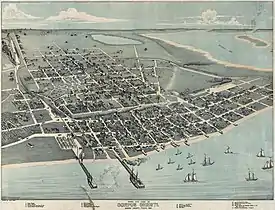
Spaniard Alonso Alvarez de Pineda traveled in 1519 to this bay on the day of the religious Feast of Corpus Christi, so named the semitropical bay Corpus Christi.[6]
Cabeza de Vaca may have passed through Corpus Christi in the 1500s, but the first European to study the Nueces River and Corpus Christi Bay was Joaquín de Orobio y Basterr in 1747. A few years later, José de Escandón organized a colony of about 50 families to settle the head of the bay, though this was short-lived.[7]
In 1839, the first known permanent settlement of Corpus Christi was established by Colonel Henry Lawrence Kinney and William P. Aubrey as Kinney's Trading Post, or Kinney's Ranch. It was a small trading post that sold supplies to a Mexican revolutionary army camped about 25 mi (40 km) west.[8] In July 1845, U.S. troops commanded by General Zachary Taylor set up camp there in preparation for war with Mexico, where they remained until March 1846. About a year later, the settlement was named Corpus Christi and was incorporated on September 9, 1852.[9]
In November 1873, seven Mexican shepherds were lynched by a mob near the city. The crime was never solved.[10]
The Battle of Corpus Christi was fought between August 12 and August 18, 1862, during the American Civil War. United States Navy forces blockading Texas fought a small land and sea engagement with Confederate forces in and around Corpus Christi Bay and bombarded the city. Union forces defeated Confederate States Navy ships operating in the area, but were repulsed when they landed on the coast.[11]
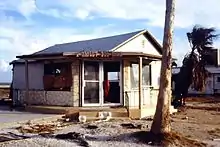
The Port of Corpus Christi was opened in 1926, and the Corpus Christi Naval Air Station was commissioned in 1941.[8]
In February 1929, the League of United Latin American Citizens (LULAC) was founded in Corpus Christi. This organization was created to battle racial discrimination against Hispanic people in the United States. Since its founding, LULAC has grown and now has a national headquarters in Washington, DC.
In March 1949, the American GI Forum (AGIF) was founded in Corpus Christi. Currently, AGIF focuses on veteran's issues, education, and civil-rights issues. This organization was founded after concerns over the segregation of Mexican-American veterans from other veterans groups and the denial of medical services based on race by the United States Department of Veterans Affairs.
The 1919 Storm devastated the city, killing hundreds on September 14. Only three structures survived the storm on North Beach.[12] To protect the city, the seawall was built. The city also suffered damage from Hurricane Celia in 1970 and Hurricane Allen in 1980, but little damage from Hurricane Ike in 2008. In 2017, the city was affected by Hurricane Harvey, then by Hurricane Hanna in 2020. Rough surf from Hurricane Laura caused one death and one injury at a beach in the city in late August 2020, just a month after Hanna.[13]
Cisneros v. Corpus Christi Independent School District (1970) was the first case to extend the U.S. Supreme Court's Brown v. the Board of Education of Topeka, Kansas decision (1954) to Mexican Americans. It recognized them as a minority group that could be and was frequently discriminated against. Such segregation and discrimination were ruled unconstitutional. Judge Woodrow Seals found that the school board consciously fostered a system that perpetuated traditional segregation. This included a system that bused Anglo students to schools out of their neighborhoods, renovated old schools in black and Mexican-American neighborhoods rather than building new ones, assigned black and Hispanic teachers to segregated schools, and limited hiring of such teachers at other schools; the school board also lacked a majority-to-minority busing system.[14]
In 2012, Corpus Christi was ranked as the second-least literate city in the U.S. in a study by Central Connecticut State University.[15]
Geography
Corpus Christi is situated on fluvial deposits that are of Holocene—Pleistocene age. Although no solidified rock occurs naturally at the surface,[16] the Deweyville Formation of sand, silt, clay, and gravel, is locally indurated with calcium carbonate (caliche) deposits. In 2017, Hurricane Harvey's storm surge eroded down to shale bedrock at a depth around 40 ft in Packery Channel, an artificial pass cut between North Padre and Mustang Islands. This feature has become a gathering place for game fish, and can be identified from the surface by its whirlpool-like current. The large, shallow bay makes Corpus Christi an ideal feeding place for birds,which is one reason why Corpus Christi is known as the "Bird Capital" of North America. Consequently, the San Diego Audubon Society has designated Corpus Christi as "America's birdiest place".[17]
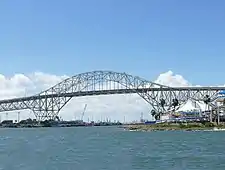
According to the United States Census Bureau, Corpus Christi has a total area of 460.2 square miles (1,192.0 km2), of which 154.6 mi2 (400.5 km2, 33.60%) are land and 305.6 mi2 (791.5 km2, 66.40%) are covered by water.
Annexation
Since its founding, the city has annexed nearby lands and waters for growth and development purposes. The original area encompassed several city blocks in present-day downtown Corpus Christi with the majority of city expansion occurring in the 20th century.[18]
Neighborhoods
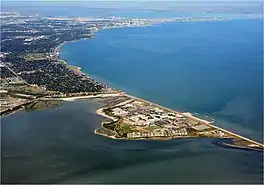
- Annaville
- Clarkwood
- Bayside
- Calallen
- Flour Bluff
- Gardendale
- Hillcrest
- North Beach
- South Side
- Mustang Island
- North Padre Island
Suburbs
Climate
The city has a humid subtropical climate (Köppen: Cfa), with hot, very humid summers and very short, mild winters. In November through February, the weather is the coolest. A noticeable warming trend occurs in March through April. The warmest part of the year is June through September, with August being the peak of summer. October in the city is very warm, but not as hot as the summer. The city itself much like the Gulf Coast of Texas experiences just two seasons, a monsoon summer from April to October and a dry winter from November to March. Corpus Christi is very windy, with wind speeds often reaching 25 miles per hour (40 km/h; 11 m/s) with gusts reaching more than 35 mph (56 km/h; 16 m/s). The city's record high temperature is 109 °F (43 °C), on September 5, 2000, and the hottest month August 2012 with an average of 88.3 °F (31.3 °C). Average night-time winter lows in January, the coldest month, are a little less than 50 °F (10 °C) and its record low is 11 °F (−12 °C) on February 12, 1899, and the coldest maximum 26 °F (−3 °C) on five occasions, the most recent being on January 30, 1951.[nb 1] Winter and early spring are generally dry, and average monthly precipitation is highest in September, when the threat from hurricanes and other tropical weather systems is greatest. The coolest month on record has been February 1905, with a mean of 45.6 °F (7.6 °C). In December 2004, the city experienced snowfall on Christmas Eve, the city's largest recorded snowstorm at 4.4 in (11 cm). The snow melted the day after Christmas. The city experienced light snowfall a second time, on December 8, 2017, nearly 13 years later.
Between 1981 and 2010, Corpus Christi averaged 31.73 in (806 mm) of rainfall; however, long periods with very little rainfall are normal, and hurricanes can frequently produce daily falls of over 4 in (100 mm). The wettest day on record is July 2, 2007, with 9.86 inches or 250 millimetres, while the wettest month on record is September 1967, with 20.33 in (516 mm), including four days with over 3 in (76 mm). Eight months with not even a trace of rainfall have happened, of which the most recent was May 1998, and 21 with merely a trace. The longest spell without measurable rainfall in Corpus Christi has been 55 days from June 23 to August 17 (inclusive) of 1895, and from June 1 to July 25 of 1915, while easily the driest calendar year has been 1917, with a mere 5.38 in (137 mm). The two wettest calendar years have been 1888 with 48.16 in (1,223 mm) and 1991 with 48.07 in (1,221 mm), although from August 1967 to July 1968, 59.09 in (1,501 mm) fell, and for the 12 months ending January 1918, only 5.22 in (133 mm).
Hurricanes seldom hit the city, but those which have were destructive, such as the 1919 Florida Keys hurricane and Hurricane Harvey in 2017.[19] The city also can see tornadoes, with an F2 tornado hitting the area on April 29, 1961.[20]
| Climate data for Corpus Christi, Texas (Corpus Christi Int'l), 1991–2020 normals | |||||||||||||
|---|---|---|---|---|---|---|---|---|---|---|---|---|---|
| Month | Jan | Feb | Mar | Apr | May | Jun | Jul | Aug | Sep | Oct | Nov | Dec | Year |
| Record high °F (°C) | 91 (33) |
97 (36) |
102 (39) |
102 (39) |
103 (39) |
107 (42) |
105 (41) |
107 (42) |
109 (43) |
101 (38) |
98 (37) |
91 (33) |
109 (43) |
| Mean maximum °F (°C) | 82.4 (28.0) |
86.6 (30.3) |
89.9 (32.2) |
92.6 (33.7) |
93.9 (34.4) |
96.0 (35.6) |
97.2 (36.2) |
99.4 (37.4) |
96.8 (36.0) |
93.1 (33.9) |
88.1 (31.2) |
83.8 (28.8) |
100.6 (38.1) |
| Average high °F (°C) | 67.9 (19.9) |
71.9 (22.2) |
76.7 (24.8) |
82.6 (28.1) |
87.3 (30.7) |
91.6 (33.1) |
93.7 (34.3) |
95.0 (35.0) |
90.8 (32.7) |
84.9 (29.4) |
76.1 (24.5) |
69.6 (20.9) |
82.3 (27.9) |
| Daily mean °F (°C) | 58.0 (14.4) |
61.9 (16.6) |
67.4 (19.7) |
73.4 (23.0) |
79.0 (26.1) |
83.2 (28.4) |
84.6 (29.2) |
85.4 (29.7) |
81.9 (27.7) |
75.1 (23.9) |
66.2 (19.0) |
59.7 (15.4) |
73.3 (22.9) |
| Average low °F (°C) | 48.0 (8.9) |
51.9 (11.1) |
58.1 (14.5) |
64.2 (17.9) |
70.7 (21.5) |
74.9 (23.8) |
75.5 (24.2) |
75.8 (24.3) |
73.0 (22.8) |
65.4 (18.6) |
56.3 (13.5) |
49.8 (9.9) |
63.6 (17.6) |
| Mean minimum °F (°C) | 30.6 (−0.8) |
33.2 (0.7) |
37.5 (3.1) |
46.5 (8.1) |
58.1 (14.5) |
67.1 (19.5) |
70.4 (21.3) |
70.4 (21.3) |
60.5 (15.8) |
47.2 (8.4) |
38.5 (3.6) |
30.1 (−1.1) |
26.5 (−3.1) |
| Record low °F (°C) | 14 (−10) |
11 (−12) |
24 (−4) |
33 (1) |
45 (7) |
56 (13) |
64 (18) |
64 (18) |
52 (11) |
28 (−2) |
27 (−3) |
13 (−11) |
11 (−12) |
| Average rainfall inches (mm) | 1.39 (35) |
1.29 (33) |
2.28 (58) |
2.04 (52) |
3.38 (86) |
3.56 (90) |
2.54 (65) |
2.75 (70) |
5.42 (138) |
3.13 (80) |
2.03 (52) |
1.93 (49) |
31.74 (808) |
| Average rainy days (≥ 0.01 in) | 7.1 | 6.5 | 5.3 | 5.3 | 6.0 | 6.8 | 5.7 | 6.5 | 8.8 | 6.3 | 6.0 | 6.4 | 76.7 |
| Average relative humidity (%) | 77.4 | 76.2 | 74.2 | 76.5 | 78.9 | 77.5 | 74.5 | 74.5 | 76.2 | 74.9 | 75.9 | 76.0 | 76.1 |
| Average dew point °F (°C) | 49.6 (9.8) |
52.7 (11.5) |
57.4 (14.1) |
63.7 (17.6) |
70.2 (21.2) |
73.9 (23.3) |
74.5 (23.6) |
73.9 (23.3) |
71.4 (21.9) |
65.1 (18.4) |
57.0 (13.9) |
50.9 (10.5) |
63.4 (17.4) |
| Mean monthly sunshine hours | 140.2 | 155.7 | 198.1 | 208.4 | 234.1 | 290.4 | 328.1 | 299.7 | 244.2 | 231.9 | 170.4 | 135.1 | 2,636.3 |
| Percent possible sunshine | 43 | 50 | 53 | 54 | 56 | 70 | 77 | 74 | 66 | 65 | 53 | 42 | 59 |
| Source: NOAA (extremes 1887–present, relative humidity and sun 1961–1990, dew point 1986–2015)[21][22] | |||||||||||||
Demographics
| Census | Pop. | Note | %± |
|---|---|---|---|
| 1860 | 100 | — | |
| 1870 | 2,140 | 2,040.0% | |
| 1880 | 3,257 | 52.2% | |
| 1890 | 4,387 | 34.7% | |
| 1900 | 4,703 | 7.2% | |
| 1910 | 8,222 | 74.8% | |
| 1920 | 10,522 | 28.0% | |
| 1930 | 27,741 | 163.6% | |
| 1940 | 57,301 | 106.6% | |
| 1950 | 108,287 | 89.0% | |
| 1960 | 167,690 | 54.9% | |
| 1970 | 204,525 | 22.0% | |
| 1980 | 231,999 | 13.4% | |
| 1990 | 257,453 | 11.0% | |
| 2000 | 277,454 | 7.8% | |
| 2010 | 305,215 | 10.0% | |
| 2020 | 317,863 | 4.1% | |
| 2021 (est.) | 317,773 | 0.0% | |
| U.S. Decennial Census[23] | |||
| Race | Number | Percentage |
|---|---|---|
| White (NH) | 96,019 | 30.21% |
| Black or African American (NH) | 12,419 | 3.91% |
| Native American or Alaska Native (NH) | 847 | 0.27% |
| Asian (NH) | 7,519 | 2.37% |
| Pacific Islander (NH) | 268 | 0.08% |
| Some Other Race (NH) | 1,144 | 0.36% |
| Mixed/Multi-Racial (NH) | 6,657 | 2.09% |
| Hispanic or Latino | 192,990 | 60.71% |
| Total | 317,863 |
As of the 2020 United States census, there were 317,863 people, 117,789 households, and 79,055 families residing in the city. At the 2010 Census, 305,215 people resided in Corpus Christi, a 10.0% increase since 2000.[27]
According to the 2010 census, 80.9% of Corpus Christi's population was White; 4.3% was African American; 1.8% Asian; 0.1% Pacific Islander; 10.4% of some other race; and 2.5% of two or more races. About 62.23% of Corpus Christi's population was of Hispanic or Latino origin, of any race,[27] and 33.3% of the population was non-Hispanic White, down from 56% in 1970.[28] In 2000,[3] the racial makeup was 71.62% White, 4.67% African American, 0.64% Native American, 1.28% Asian, 0.08% Pacific Islander, 18.58% from other races, and 3.13% from two or more races. Hispanics of any race were 54.33% of the population.
Economy
The majority of the population is employed in the services, wholesale and retail trades, and government sectors. Corpus Christi has an unemployment rate of 4.5% as of July 2019.[29]
The Port of Corpus Christi, which is the fifth-largest U.S. port[30] and deepest inshore port on the Gulf of Mexico, handles mostly oil and agricultural products. Much of the local economy is driven by tourism and the oil and petrochemicals industry.[31] In 2005, the port was ranked as the 47th-largest in the world by cargo tonnage.
Corpus Christi is home to Naval Air Station Corpus Christi, providing 6,200 civilian jobs to the local economy, making it the single largest employer in the city. Corpus Christi Army Depot, located on NAS Corpus Christi, is the largest helicopter repair facility in the world.[9] Additionally located on NAS Corpus Christi is the United States Coast Guard Sector/Air Station Corpus Christi.
Corpus Christi is the original home of the headquarters of Whataburger, a fast-food restaurant operator and franchiser with 650 stores in 10 states and Mexico; the company relocated its headquarters to San Antonio in 2009. Other large employers include CHRISTUS Spohn Health System at 5,400 local employees, the Corpus Christi Independent School District with 5,178, H-E-B at 5,000, and Bay Ltd. at 2,100.[32] Other companies based in Corpus Christi include Stripes Convenience Stores and AEP Texas.[33][34]
Corpus Christi became the first major city to offer citywide free wi-fi in April 2005 [35] to allow remote meter reading after a meter reader was attacked by a dog. In 2007, the network was purchased by Earthlink for $5.5 million, and stopped being a free service on May 31, 2007.[36]
Culture
Various sections of Corpus Christi maintain distinct senses of identity and community from the city proper, especially the Calallen and Flour Bluff areas.
Attractions
The city is home to a number of popular destinations for both tourists and residents. The official visitor and tourism information organization is the Corpus Christi Convention and Visitors Bureau. Some of the most visited attractions are located on North Beach, where the Texas State Aquarium and the USS Lexington Museum on the Bay are located.[37]
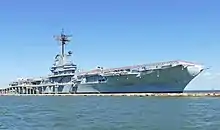

USS Lexington was also part of the set for the 2001 film Pearl Harbor. Corpus Christi's museum district is located near USS Lexington. Some attractions located in the museum district are the Museum of Asian Cultures, the Corpus Christi Museum of Science and History, the South Texas Institute for the Arts, and the Harbor Playhouse Theatre, one of the oldest continually operating community theatres in Texas. Heritage Park is also in the museum district, where a number of older restored houses can be found. The downtown area, of which the museum district is a part, is home to skyscrapers such as One Shoreline Plaza, company offices, various shops, a popular center of marinas, and Mirador de la Flor. Downtown also is home of the Texas Surf Museum, which explores the history of surfing and focuses on surf culture along Texas' 367 mi (591 km) coast, as well as K Space Contemporary, a nonprofit art organization promoting and presenting local, regional, and national contemporary art.
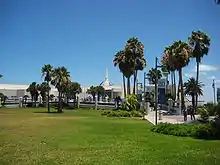
The Corpus Christi Botanical Gardens and Nature Center, also located in the city, hosts gardening programs from time to time. On Oso Bay near the Pharaoh Valley subdivision, the Hans and Pat Suter Wildlife Refuge is known for seabird-watching. The nearby Pharaohs golf course also serves as a haven for coastal and migratory birds.
Directly east of Corpus Christi are Padre Island and Mustang Island, home to various municipal, state, and national parks, most notably the Padre Island National Seashore. The city is also near King Ranch, one of the world's largest ranches, upon which the movie Giant was based.
Sports
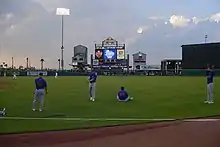
Corpus Christi has professional and amateur sports to offer residents and visitors. The city is home to the Corpus Christi IceRays of the North American Hockey League and the Corpus Christi Hooks, of the Texas League, and the AA affiliate of the Houston Astros. The largest venue in Corpus Christi is the 18,000-capacity American football stadium named Buccaneer Stadium.
Year-round NCAA Division I collegiate athletics may be found at Texas A&M-Corpus Christi as the Islanders compete in 14 men's and women's sports as a member of the Southland Conference.
Sailing races are held weekly off downtown's T-heads every Wednesday, where spectators watch vessels competing at sunset. Additionally, Corpus Christi is also home to the Corpus Christi Rugby Football Club, which is a member of the Texas Rugby Union, an affiliate of the Western Rugby Union and of the United States Rugby Football Union.
In 2017, the United Soccer League expanded to Corpus Christi, forming Corpus Christi FC. Corpus Christi FC plays in the Mid-South Division of the USL League Two.
In 2023, the American Indoor Football expanded to Corpus Christi, forming Corpus Christi Tritons.
| Club | Sport | League | Venue | Established | Championships |
|---|---|---|---|---|---|
| Corpus Christi Hooks | Baseball | Texas League | Whataburger Field | 1968 (Relocated in 2005) | 1 (2006) |
| Corpus Christi Tritons | Indoor football | AIF | American Bank Center | 2023 | N/A |
| Corpus Christi IceRays | Ice hockey | NAHL | American Bank Center | 1998 (Became junior in 2010) | 0 |
| Corpus Christi Crabs | Rugby | TRU | Dewey's | 1973 | N/A |
| Corpus Christi FC | Soccer | USL2 | St. John Paul II High School Stadium | 2017 | N/A |
Parks and recreation
The city's location beside Corpus Christi Bay, the Gulf of Mexico, and Laguna Madre provides opportunities for water sports and nature tourism. Waterfowl hunting is available in the region for duck, geese, coot, and teal. White-winged dove and mourning dove are also hunted on private leases. The brushland inland from Corpus Christi is also ideal for hunting feral hogs and white-tailed deer.
Fishing
Fishing is a popular recreational activity in Corpus Christi, including fishing from various piers around Corpus Christi Bay, wade fishing in Oso Bay, and fishing from the Gulf of Mexico at Packery Channel or at Bob Hall Pier.
Wind sports
The city has one of the highest average wind speeds of coastal cities in North America.[38] This, combined with the Bay Front area located along Ocean Drive, makes the city an important destination for wind sports such as kite boarding, wind surfing, kite flying, wing foiling, and sailing. In 1990, Corpus Christi hosted the Windsurfing World Championships. In 2018, Corpus Christi hosted the 2018 Youth Sailing World Championships, and in 2022, the J/24 World Championship.
Skating
The Corpus Christi Skate Park opened on February 17, 2007. It is located in Cole Park on the shoreline of the Corpus Christi Bay near downtown. The 12,000-square-foot (1,100 m2) concrete park includes a skating bowl and a street course with stairs, railings, and flat surfaces.
Birdwatching
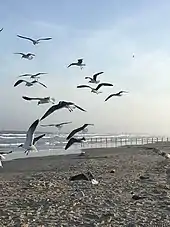
Being a coastal city, Corpus Christi is a good spot for seabird watching. Popular spots include Blucher Park in downtown, the Hans and Pat Suter Wildlife Refuge along Oso Bay, Hazel Bazemore County Park along the Nueces River in Calallen, and the South Texas Botanic Garden and Nature Center along the Oso Creek.[39]
The Audubon Outdoor Club of Corpus Christi, founded in 1957, promotes birding culture and protects habitat for birds in the Coastal Bend region of Texas,[40] with five sanctuaries owned or managed by the club within Corpus Christi.[41] The club hosts field trips and public meetings monthly.
Government
Municipal government
In 1852, the City of Corpus Christi was incorporated. Texas' 31st Legislature chartered the city as a political and corporate municipal entity in 1909. By ordinance, the city possesses power to "fix, alter and extend its boundaries."[42]
Corpus Christi is under a council-manager municipal government. The elected city council is the primary authority in municipal matters such as enacting local legislation, determining policies, and appointing the city manager. Together, the city council and city manager execute laws and administer the municipal government.[42] Organized by governmental sectors of city council, city management, city secretary, and several city departments, Corpus Christi is seated in Nueces County. The city council currently consists of these elected members:
- Mayor Paulette Guajardo
- Michael Hunter, At-Large
- John Martinez, At-Large
- Mike Pusley, At-Large
- Billy A. Lerma, District 1
- Ben Molina, District 2
- Roland Barrera, District 3
- Greg Smith, District 4
- Gil Hernandez, District 5[43]
Peter Zanoni, former deputy city manager of San Antonio, was appointed city manager in May 2019. Upon appointment, Zanoni created two new positions in his leadership team and appointed Michael Rodriguez as his Chief of Staff[44] and Constance Sanchez as Chief Financial Officer.[45] The city manager works alongside Assistant City Manager Steven Viera. The city's intergovernmental relations director is Tammy Embrey. Rebecca L. Huerta serves as the city secretary.
Former City Manager Margie C. Rose was appointed in 2016 and served as the first African-American city manager in Corpus Christi. Rose resigned in 2018.[46] Selman served as interim city manager in 2018 following Rose's resignation and until the appointment of Zanoni.
The Corpus Christi City Charter was adopted by public referendum in 1987, with amendments to the entire charter conducted January 19, 1991, and April 3, 1993. Further revisions to the charter were conducted on November 2, 2004, November 7, 2006, and November 8, 2016.[47] The charter consists of 10 articles and 41 sections regarding stipulations of home rule government, city council and city manager procedures, administration, planning, boards and commissions, etc. The Code of Ordinances of Corpus Christi was codified through Ordinance No. 028493, and adopted Feb. 23, 2010.[48]
From 2012 to 2016, Nelda Martinez was mayor of Corpus Christi, the first Hispanic woman to the hold the office.[49]
On January 19, 2017, Corpus Christi Mayor Dan McQueen resigned from office after 37 days, an outgrowth of a comment by McQueen claiming that the city council members were only high school graduates and he was an engineer.[50] He does not have an engineering degree and some college graduates are on the city council.[50]
State and federal representation
The Texas 13th Court of Appeals is located in the Nueces County Courthouse in Corpus Christi.[51]
The Texas Department of Criminal Justice operates the Corpus Christi Parole Office in Corpus Christi.[52]
The United States Postal Service operates the Corpus Christi Post Office, the city's main post office,[53] and several station post offices.
Education
Colleges and universities
Corpus Christi is home to several institutions of higher learning: Texas A&M University-Corpus Christi, Del Mar College, Saint Leo University-Corpus Christi,[54] and numerous vocational schools, including Southern Careers Institute, South Texas Vo-Tech, Career Centers of Texas-Corpus Christi, and Vogue Cosmetology School. The city is also home to Stark College and Seminary (formerly known as the South Texas School of Christian Studies), located on Ward Island alongside Texas A&M-Corpus Christi.
Texas A&M University-Corpus Christi is a component of the Texas A&M University System. It was formerly known as Corpus Christi State University, Texas A&I University at Corpus Christi, and the University of Corpus Christi.
Saint Leo University-Corpus Christi Education Center[54] is located at Corpus Christi's Naval Air Station.
Del Mar College is a local community college designated for the entire Corpus Christi city limits.[55] It began in the 1940s at a location behind Wynn Seale Jr. High School. The main campus began with the administration building, which was constructed after World War II on Del Mar. The college grew to encompass a good portion of a residential addition called Southmoreland built from the Bohemian farmlands in the late 1930s. Del Mar now includes a west campus located in the area of Corpus Christi that once was Cliff Maus Airport. Del Mar College is expanding their footprint with the unveiling of their new Southside Campus near Oso Creek. The new Southern branch campus will serve the recent growing Southside area.
Southern Careers Institute offers career training at two Corpus Christi locations, primarily in the medical, business, and cosmetology fields.
In 2015, WalletHub ranked Corpus Christi near the bottom, 138 out of 150 cities in America, for its low educational level and low-income opportunities. To improve literacy levels in the city, a multiyear effort has been made to promote reading through annual literacy festivals. Started by First Lady Laura Bush and the Texas Book Festival, a series of book festivals is held each spring.
Schools
Seven school districts provide primary and secondary education for residents of the city limits, within Nueces County:[56]
- Corpus Christi ISD
- Calallen ISD
- Flour Bluff ISD
- London ISD
- Port Aransas ISD
- Tuloso-Midway ISD
- West Oso ISD
The portion of Corpus Christi in Kleberg County is within the Riviera Independent School District.[57] The portion in San Patricio County is in the Ingleside Independent School District.[58]
The Roman Catholic Diocese of Corpus Christi provides the primary and secondary education for Catholic schools. Several Open Enrollment Charter Schools are in Corpus Christi. These public schools are: Accelerated Learning Center, Cesar E Chavez Academy, Corpus Christi College Preparatory HS, Corpus Christi Montessori School, Dr ML Garza-Gonzalez Charter School, GCCLR Institute of Technology, Premier HS of Corpus Christi, Richard Milburn Academy, School of Science and Technology, Seashore Learning Center, and Seashore Middle Academy (Archived 2016-02-21 at the Wayback Machine).
Corpus Christi Independent School District
High Schools
- Mary Carroll High School
- Richard King High School
- Roy Miller High School
- Foy H. Moody High School Health Science Academy
- W. B. Ray High School
- Collegiate High School
- Solomon Coles High School
- Branch Academy for Career and Technical Education
- Veterans Memorial High School
- School of Science and Technology College Prep High School
Middle Schools
- Marvin P. Baker Middle School
- Tom Browne Middle School
- Cullen Place Middle School
- Claude Cunningham Middle School
- Robert Driscoll Middle School
- Elliott Grant Middle School
- Carl O. Hamlin Middle School
- R. Haas Middle School
- Harold Kaffie Middle School
- Martin Middle School
- South Park Middle School
- Wynn Seale Academy of Fine Arts Magnet Middle School
Elementary Schools
- Allen Elementary School
- Barnes Elementary School
- Berlanga Elementary School
- Calk Elementary School
- Club Estates Elementary School
- Crockett Elementary School
- Dawson Elementary School
- Early Childhood Development Center
- Evans Elementary School
- Fannin Elementary School
- Galvan Elementary School
- Garcia Elementary School
- Gibson Elementary School
- Hicks Elementary School
- Houston Elementary School
- Jones Elementary School
- Kolda Elementary School
- Kostoryz Elementary School
- Los Encinos SES Elementary School
- Meadowbrook Elementary School
- Menger Elementary School
- Metropolitan Elementary School of Design
- Mireles Elementary School
- Montclair Elementary School
- Moore Elementary School
- Oak Park Elementary School
- Sanders Elementary School
- Schanen Estates Elementary School
- Shaw Elementary School
- Smith Elementary School
- Travis Elementary School
- Webb Elementary School
- Wilson Elementary School
- Windsor Park Elementary School
- Woodlawn Elementary School
- Yeager Elementary School
- Zavala Elementary School
Alternative
- Student Learning and Guidance Center
- Mary Grett School
Flour Bluff Independent School District
- Flour Bluff High School grades 9–12
- Flour Bluff Jr. High School grades 7–8
- Flour Bluff Intermediate School grades 5–6
- Flour Bluff Elementary School grades 3–4
- Flour Bluff Primary School grades 1–2
- Early Childhood Center prekindergarten and kindergarten
- Head Start ages 1–4
West Oso Independent School District
- West Oso High School grades 9–12
- West Oso Junior High School grades 6–8
- West Oso Elementary grades 2–5
- West Oso John F. Kennedy Elementary prekindergarten to grade 1
Tuloso-Midway Independent School District
- Tuloso-Midway High School
- Tuloso-Midway Middle School
- Tuloso-Midway Intermediate School
- Tuloso-Midway Primary School
- Tuloso-Midway Academic Career Center
Calallen Independent School District
- Calallen High School
- Calallen Middle School
- West Intermediate School grades 4–5
- East Primary School grades pre-K–3
- Wood River Primary School grades pre-K–3
London Independent School District
- London High School
- London Middle School
- London Elementary School
Private/charter/other
- John Paul II High School (8–12)
- Bishop Garriga Middle School (6th-8th grade campus)
- St. James Episcopal (primary, K–8)
- Corpus Christi Montessori School (grades 1–8)
- Incarnate Word Academy (K–12)
- Annapolis Christian Academy (K–12)
- Yorktown Christian Academy (K–12)
Libraries
Libraries in the city include:[59]
- Dr. Clotilde P. Garcia, 5930 Brockhampton
- Ben F. McDonald, 4044 Greenwood
- Janet F. Harte, 2629 Waldron
- La Retama, 805 Comanche
- Owen R.Hopkins, 3202 McKinzie
- Anita & W.T. Neyland, 1230 Carmel Pkwy
TexShare card holders also have limited borrowing privileges at these area libraries:[60]
- Nueces County Public Library in Robstown, Texas
- Mary and Jeff Bell Library at Texas A&M University-Corpus Christi
- Del Mar College Libraries
Infrastructure
Transportation
Corpus Christi is served by Corpus Christi International Airport and Interstate 37. Interstate 69E/U.S. Highway 77 connects the city to Brownsville and Victoria. Texas State Highway 44 is a main thoroughfare that connects Corpus Christi to Laredo and the western part of South Texas by way of Interstate 69W/U.S. Highway 59, Interstate 35, and U.S. Highway 83. The inner-city public transportation is provided by Corpus Christi Regional Transportation Authority with its 28 bus routes. Corpus Christi once had a streetcar system functioning from 1910 to 1931 and a railway station (passenger service ended in 1965). Despite the convenience of a large harbor, the city does not have a passenger port. The city of Corpus Christi has a lower than average percentage of households without a car. In 2015, 8.5% of Corpus Christi households lacked a car, and decreased slightly to 7.9% in 2016. The national average was 8.7% in 2016. Corpus Christi averaged 1.77 cars per household in 2016, compared to a national average of 1.8.[61]
The city is accessed by two major bridges, the Harbor Bridge (US 181) and the John F. Kennedy Memorial Causeway (PR 22). Both bridges are maintained by the Texas Department of Transportation.
Major highways
.svg.png.webp) Interstate 37
Interstate 37.svg.png.webp) Interstate 69E; under construction and extension following US 77
Interstate 69E; under construction and extension following US 77 U.S. Highway 77
U.S. Highway 77 U.S. Highway 181
U.S. Highway 181 Texas State Highway 44
Texas State Highway 44 Texas State Highway 286 (Crosstown Expressway)
Texas State Highway 286 (Crosstown Expressway) Texas State Highway 358 (North Padre Island Drive and South Padre Island Drive)
Texas State Highway 358 (North Padre Island Drive and South Padre Island Drive) Texas State Highway 35
Texas State Highway 35 Texas State Highway 361
Texas State Highway 361 Texas State Highway 357
Texas State Highway 357
Water
Drinking water for the city is supplied by three reservoirs, Lake Corpus Christi, the Choke Canyon Reservoir, and Lake Texana. Through an effective regional partnership with the Nueces River Authority and the Port of Corpus Christi Authority, a 101 mi (163 km) pipeline was built which transports water from Lake Texana to the city's O.N. Stevens Water Treatment Plant. It was named the Mary Rhodes Pipeline, after the late mayor. Phase two of the pipeline is underway to draw water from the Colorado River.[62] All reservoirs are outside the city limits, but Lake Corpus Christi and Choke Canyon Reservoir are managed directly by the public utility of the City of Corpus Christi. To support future water needs, plans are being completed to build a desalinization plant.[63][64][31]
Notable people
- Jimmy Akin, Catholic podcast host
- Kevin Abstract, musician, founding member of Brockhampton
- Amy Acuff, five-time Olympic high jumper
- Mike Adams, former MLB pitcher
- Devon Allman, musician
- A.A. Allen, Pentecostal evangelist and "faith healer", pastored an Assemblies of God church in Corpus Christi in the late 1940s
- Marshall Applewhite, founder of the Heaven's Gate suicide cult, graduated from Corpus Christi High School
- Barbara Barrie, actress
- Raymond Berry, wide receiver and coach, Pro Football Hall of Famer
- Phil Blackmar, golfer, three-time winner on PGA Tour and single win on Champions Tour
- Justin Brantly, NFL punter
- John A. Brieden, American Legion commander
- Tammie Brown, drag queen and musician
- Rick Baldwin, NASCAR driver
- Johnny Canales, TV host
- Dabney Coleman, actor
- Roger Creager, country music singer-songwriter
- Henry Cuesta, clarinetist on The Lawrence Welk Show
- Dave Davies, American broadcaster and contributor to NPR's Fresh Air program
- Paula DeAnda, musician
- Tom DeLay, former U.S. Congressman and House Majority Leader
- Carlos DeLuna, executed for murder, controversial conviction causing concerns about wrongful executions
- Iann Dior, singer, rapper, and songwriter
- Helen Donath, opera singer
- Ramón H. Dovalina, college administrator and president
- Roberto Elizondo, boxer, two time world title challenger
- Farrah Fawcett, actress and artist
- Frances Farenthold, member, Texas House of Representatives (1969-1973), activist, educator
- Blake Farenthold, former U.S. Congressman from Texas 27th District
- Joe Bertram Frantz, historian
- David Freese, MLB player for Pittsburgh Pirates
- Albert Lee Giddens, Texas trial lawyer
- Clint Gresham, Seattle Seahawks long snapper, Super Bowl champion
- Stephanie Griest, author
- Steven A. Hickham Jr., racing driver
- Jim Heath, musician known as Reverend Horton Heat
- Burt Hooton, baseball pitcher, All-Star and World Series champion
- Todd Ames Hunter, member of Texas House of Representatives, 1989–1997 and since January 2009
- Ernestine Jackson, actress and singer
- Bret Anthony Johnston, author of Corpus Christi: Stories
- Jeremy Jordan, Supergirl (TV series) actor, Joyful Noise (movie actor), Broadway performer
- Jeff Kanipe, author and astronomer
- Larry Kelm, NFL player, an original member of Texas A & M "Wrecking Crew", linebacker for Los Angeles Rams and San Francisco 49ers
- Ashley Kidd, world champion wakesurfer
- Brooks Kieschnick, baseball player
- Bobby Labonte, NASCAR Sprint Cup driver and 2000 champion
- Terry Labonte, NASCAR Sprint Cup driver and 1984 and 1996 champion
- Colleen LaRose, indicted in 2010 for trying to recruit Islamic terrorists to wage jihad
- Chris Layton, drummer for Stevie Ray Vaughan and Double Trouble
- Brian Leetch, NHL defenseman, born in Corpus Christi, but grew up in Connecticut
- Danny Lohner, musician
- Eva Longoria, actress (Desperate Housewives)
- Allen Ludden, TV game show host
- Terrence McNally, playwright
- Irlene Mandrell, musician, actress, model, sister of Barbara and Louise Mandrell
- Louise Mandrell, singer and entertainer, sister of Barbara and Irlene Mandrell
- Victoria Moroles, actress
- Mitch Morris, actor
- Roger Narvaez, Mixed Martial Artist
- Larry Norman, musician and songwriter
- Todd Oldham, fashion designer
- Revilo P. Oliver, professor and founder of John Birch Society
- Solomon P. Ortiz, U.S. Congressman, represented Corpus Christi for 28 years
- Jessie Pavelka, actor and model
- Jennifer Peña, Latin Pop and Tejano singer and actress
- Cliff Pennington, MLB player for the Los Angeles Angels
- Paul Peress, drummer, composer, producer
- Lou Diamond Phillips, actor
- Billy Powell, keyboardist
- Selena Quintanilla-Pérez, Mexican/American Tejano singer, Queen of Tejano music, with Selena Y Los Dinos
- A.B. Quintanilla, singer, songwriter with Kumbia All Starz, Selena's older brother
- Suzette Quintanilla, drummer for Selena y Los Dinos, Selena's older sister
- Dody Roach, professional poker player, two-time World Series of Poker bracelet winner
- Johnny Roland, NFL player and coach
- Lester Roloff, radio evangelist
- Leslie Sanchez, political pundit
- Pepe Serna, actor
- Sid Sheinberg, ex-president of Universal Studios, helped make Jaws
- Bart Shirley, MLB player for Los Angeles Dodgers and New York Mets
- Ormond R. Simpson, Lieutenant general in the Marine Corps
- Robert Simpson, meteorologist and hurricane specialist
- Lori Singer, actress
- Marc Singer, actor
- Justin Storms, artist, musician
- Martha Tilton, singer and actress
- Raul Torres, state representative from Nueces County
- Carlos Truan, politician
- e.E. Charlton-Trujillo, author, filmmaker and youth literacy activist
- George Conrad Westervelt, naval officer and engineer; co-founder of the Boeing Company
- April Wilkerson, American maker, YouTube content creator, TV Personality
- Don Williams, country and western singer
- Rob Zastryzny, Pitcher for the Chicago Cubs
Sister cities
Corpus Christi keeps a thriving and active relationship with these sister cities:[65]
See also
References
- "US Census change list". Census.gov. January 7, 2009. Archived from the original on August 6, 2010. Retrieved May 22, 2010.
- "2019 U.S. Gazetteer Files". United States Census Bureau. Archived from the original on October 17, 2020. Retrieved August 7, 2020.
- "U.S. Census website". United States Census Bureau. Archived from the original on December 27, 1996. Retrieved January 31, 2008.
- U.S. Geological Survey Geographic Names Information System: Corpus Christi, Texas
- "Find a County". National Association of Counties. Archived from the original on May 31, 2011. Retrieved June 7, 2011.
- "The Spanish - Padre Island National Seashore". National Park Service. May 9, 2017. Archived from the original on April 3, 2021. Retrieved March 4, 2021.
- Long, Christopher Long (June 12, 2010). "Corpus Christi, TX". Handbook of Texas Online. Texas State Historical Association. Archived from the original on July 19, 2018. Retrieved May 26, 2018.
- "Corpus Christi, History, Historical, Interesting". Downtowncorpuschristi.com. Archived from the original on March 18, 2009. Retrieved May 22, 2010.
- "Official web site for City of Corpus Christi, Texas". Cctexas.com. Archived from the original on January 28, 2016. Retrieved May 22, 2010.
- Carrigan, William D; Webb, Clive (February 20, 2015). "When Americans Lynched Mexicans". The New York Times.
- "TSHA | Corpus Christi, Battle of". Archived from the original on October 22, 2019. Retrieved June 25, 2017.
- "MURPHY GIVENS: Storm of the century swept across North Beach". Archived from the original on September 6, 2015. Retrieved April 18, 2016.
- Willetts, Mitchell (August 26, 2020). "Surfer dies riding rough Gulf Coast waves as Hurricane Laura churns toward Texas". Star Telegram. Archived from the original on May 4, 2021. Retrieved March 4, 2021.
- "CISNEROS V. CORPUS CHRISTI ISD". Texas State Historical Association. June 12, 2010. Archived from the original on September 8, 2015. Retrieved August 15, 2015.
- "Corpus Christi ranks next to last among U.S. Most Literate big cities - Caller-Times". Archived from the original on July 13, 2015. Retrieved April 18, 2016.
- texascoastgeology.com
- "Add hawkiest to our birdiest city distinction". Archived from the original on August 26, 2017. Retrieved May 4, 2017.
- "City Annexation Map" (PDF). City of Corpus Christi. Archived (PDF) from the original on January 14, 2016. Retrieved January 2, 2015.
- "Hurricane Harvey makes landfall in Texas". The Guardian. Archived from the original on August 26, 2017. Retrieved August 26, 2017.
- "Tornado History Project: 19610429.48.37". www.tornadohistoryproject.com. Archived from the original on January 28, 2011. Retrieved July 21, 2020.
- "NowData – NOAA Online Weather Data". National Oceanic and Atmospheric Administration. Archived from the original on May 5, 2021. Retrieved May 4, 2021.
- "WMO Climate Normals for Corpus Christi/INTL, TX 1961–1990". National Oceanic and Atmospheric Administration. Retrieved December 19, 2016.
- "Census of Population and Housing". Census.gov. Archived from the original on October 3, 2014. Retrieved June 4, 2015.
- "Explore Census Data". data.census.gov. Retrieved May 21, 2022.
- Bureau, US Census. "Census.gov". Census.gov.
- "About the Hispanic Population and its Origin". www.census.gov. Retrieved May 18, 2022.
- "factfinder.census.gov". United States Census. United States Census Bureau. Archived from the original on February 10, 2020.
- "Texas - Race and Hispanic Origin for Selected Cities and Other Places: Earliest Census to 1990". U.S. Census Bureau. Archived from the original on August 12, 2012. Retrieved April 30, 2012.
- "Corpus Christi, TX Economy at a Glance". Bls.gov. Archived from the original on February 8, 2017. Retrieved February 7, 2017.
- "U.S. port ranking by cargo volume 2008" (PDF). Archived (PDF) from the original on September 29, 2011. Retrieved November 2, 2011.
- Baddour, Dylan (November 4, 2022). "Corpus Christi sold its water to Exxon and is losing its big bet on desalination". Ars Technica. Inside Climate News. Retrieved November 4, 2022.
- "City of Corpus Christi CAFR" (PDF). Archived (PDF) from the original on November 5, 2011. Retrieved May 27, 2011.
- Susser Holdings – About Us Archived 2011-12-28 at the Wayback Machine
- "AEP Texas – Facts, Figures & Bios". Archived from the original on October 6, 2011. Retrieved December 12, 2011.
- "Corpus Christi Texas Extends Free Wi-Fi". Archived from the original on June 4, 2015. Retrieved June 4, 2015.
- "EarthLink Dedicates Wi-Fi Network In Corpus Christi". Informationweek.com. Archived from the original on December 13, 2007. Retrieved May 22, 2010.
- "Corpus Christi CVB Vacation Information". Visitcorpuschristitx.org. Archived from the original on July 26, 2010. Retrieved May 22, 2010.
- Wind Average Data: University of Utah: "National - Average Wind Speed". Archived from the original on December 9, 2006. Retrieved January 10, 2007.
- "birding hot spots". Archived from the original on September 11, 2015. Retrieved August 16, 2015.
- "About Us". Audubon Outdoor Club of Corpus Christi. Retrieved July 10, 2023.
- "Conservation". Audubon Outdoor Club of Corpus Christi. Retrieved July 10, 2023.
- Citgo Online GrayBook Archived 2011-01-16 at the Wayback Machine, Corpus Christi.
- " Archived 2015-11-22 at the Wayback Machine." City Government Website for the city of Corpus Christi, Texas. Retrieved on Dec 9, 2015.
- "Chief of Staff, Michael Rodriguez | City of Corpus Christi". www.cctexas.com. Archived from the original on October 25, 2019. Retrieved October 25, 2019.
- "Chief Financial Officer, Constance Sanchez | City of Corpus Christi". www.cctexas.com. Archived from the original on October 25, 2019. Retrieved October 25, 2019.
- " Archived 2013-02-06 at the Wayback Machine." City Government Website for the city of Corpus Christi, Texas. Retrieved on Jun 1, 2013.
- "Corpus Christi City Charter Archived 2010-01-02 at the Wayback Machine." City Charter, Official Website of Corpus Christi Retrieved on March 29, 2010.
- "Municipal Code." Code of Ordinances of Corpus Christi Retrieved on March 29, 2010.
- Woolbright, Matt. Mayor Nelda Martinez bids farewell to City Council dais Archived 2021-04-17 at the Wayback Machine, Corpus Christi Caller Times, November 15, 2016.
- Bogan, Ray. Corpus Christi mayor resigns after just 37 days Archived 2018-09-26 at the Wayback Machine, FOX News, January 19, 2017.
- "Contact Information Archived 2010-01-25 at the Wayback Machine." Thirteenth Eleventh Court of Appeals. Retrieved on March 10, 2010.
- "Parole Division Region IV Archived 2011-09-04 at the Wayback Machine." Texas Department of Criminal Justice. Retrieved on May 21, 2010.
- "Post Office Location – CORPUS CHRISTI Archived 2010-06-21 at the Wayback Machine." United States Postal Service. Retrieved on May 21, 2010.
- "Corpus Christi Education Center". Archived from the original on July 2, 2017. Retrieved April 24, 2015.
- "Texas Education Code Sec. 130.177. Del Mar College-corpus Christi Junior College District Service Area". Archived from the original on September 22, 2021. Retrieved May 14, 2021.
- "2020 Census - School District Reference Map: Nueces County, TX" (PDF). U.S. Census Bureau. Retrieved June 28, 2022.
- "2020 Census - School District Reference Map: Kleberg County, TX" (PDF). U.S. Census Bureau. Retrieved June 28, 2022.
- "2020 Census - School District Reference Map: San Patricio County, TX" (PDF). U.S. Census Bureau. Retrieved June 28, 2022.
- "Corpus Christi Public Libraries". Archived from the original on January 5, 2019. Retrieved December 9, 2021.
- TexShare Card Program – Patron Information Page Archived 2009-07-05 at the Wayback Machine. Accessed 7 April 2009.
- "Car Ownership in U.S. Cities Data and Map". Governing. December 9, 2014. Archived from the original on May 11, 2018. Retrieved May 4, 2018.
- "Mary Rhodes Pipeline Phase 2 Project Fact Sheet" (PDF). Archived from the original (PDF) on September 29, 2015. Retrieved August 15, 2015.
- "CORPUS CHRISTI MOVING NEARER CONSTRUCTION OF DESALINATION PLANT". Archived from the original on September 30, 2015. Retrieved August 16, 2015.
- Baddour, Dylan (October 29, 2022). "Black residents in Corpus Christi file a civil rights complaint to stop Texas' first desalination plant". The Texas Tribune. Inside Climate News. Retrieved November 4, 2022.
- "Sister Cities". Sister Cities Committee Of Corpus Christi. Archived from the original on June 28, 2014. Retrieved March 4, 2014.
Notes
- The other cases of a 26 °F (−3 °C) maximum have been December 20, 1924, February 12, 1899, January 25, 1897, and January 16, 1888.
Further reading
- Lessoff, Alan. Where Texas Meets the Sea: Corpus Christi and Its History (University of Texas Press, 2015) 360 pp.
- Givens, Murphy. Corpus Christi: A History
External links
- City of Corpus Christi
- Corpus Christi Public Library Digital Archive, features local history photographs and materials
